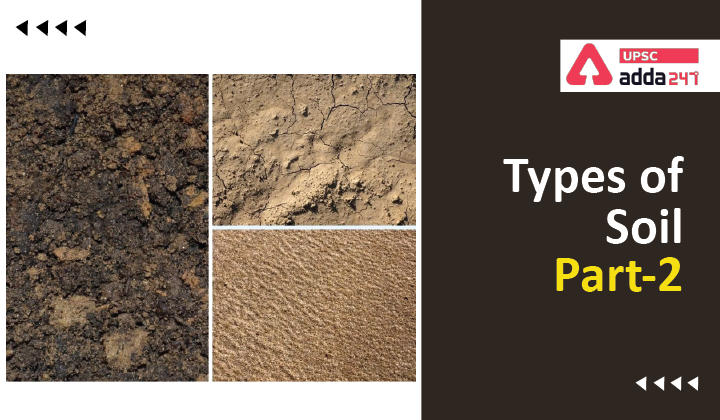Table of Contents
Types of soil in India
Soil is the mixture of rock debris and organic materials which develop on the earth’s surface. However, whole of the soil is not same and differs in its constituents. In the previous article, we discussed about alluvial soil and black soil. In this article, we will discuss about red soil, laterite soil and forest or mountain soil.

Red and yellow soil
- Red soil occupies the second largest area in India, after alluvial soil.
- Red soil develops on crystalline igneous rock like acid granites, gneisses and quartzites.
Characteristics of red soil
- The soil develops a reddish colour due to a wide diffusion of iron (ferric oxides) in crystalline and metamorphic rocks. It looks yellow when it occurs in a hydrated form.
- The texture of the soil varies from sandy to clayey and loamy.
- The fine-grained red and yellow soils are normally fertile, whereas coarse-grained soils found in dry upland areas are poor in fertility.
Chemical composition of red soil
- They are generally acidic due to the presence of iron oxides.
- They are generally poor in nitrogen, magnesia, phosphorous and humus.
- They are fairly rich in potassium.
Distribution of red soil
- These soils mostly occur in the regions of low rainfall in the eastern and southern part of the Deccan Plateau.
- These soils are spread on almost the whole of Tamil Nadu.
- Yellow and red soils are also found in parts of Odisha and Chhattisgarh and in the southern parts of the middle Ganga plain.
- Along the piedmont zone of the Western Ghat, long stretch of area is occupied by red loamy soil.
Crops in red soil
- Once irrigated and added with humus, red soil gives a high yield because of the rich mineral base.
- Red soil also supports the cultivation of rice, sugarcane, cotton cultivation
- In dry areas, millets and pulses are grown.
Laterite soil
- Laterite has been derived from the Latin word ‘Later’ which means brick.
- These types of soils are mostly the end products of weathering.
- The laterite soils develop in areas with high temperature and high rainfall.
- These are the result of intense leaching due to tropical rains.
- Laterite soils are widely cut as bricks for use in house construction.
Characteristics of laterite soil
- Due to rain, lime and silica are leached away, and soils rich in iron oxide and aluminium compound are left behind.
- Humus content of the soil is removed fast by bacteria that thrives well in high temperature.
- Laterite soils are poor in organic matter, nitrogen, phosphate and calcium, while iron oxide and potash are in excess.
- Hence, laterites are not suitable for cultivation; however, application of manures and fertilisers are required for making the soils fertile for cultivation.
Distribution of laterite soils
- Red laterite soils in Tamil Nadu, Andhra Pradesh and Kerala are more suitable for tree crops like cashewnut.
- The laterite soils are commonly found in Karnataka, Kerala, Tamil Nadu, Madhya Pradesh and the hilly areas of Odisha and Assam.
Crops in laterite soil
- Laterite soil lacks fertility due to leaching.
- However, with fertilisers and irrigation, some laterites are suitable for growing plantation crops like tea, coffee, rubber, coconut, arecanut, etc.
Mountainous or Forest Soils
- Forest soils are formed in the forest areas where sufficient rainfall is available.
- They are mainly heterogeneous soils found on the hill slopes covered by forests.
- The soils vary in structure and texture depending on the mountain environment where
they are formed. - Due to this reason, they differ greatly even if they occur in close proximity to one another.
- They are loamy and silty on valley sides and coarse-grained in the upper slopes.
- In the snow-bound areas of the Himalayas, they experience denudation, and are acidic with low humus content. The soils found in the lower valleys are fertile.
Chemical composition of forest soil
- The forest or mountain soils are very rich in humus due to the presence of organic matter.
- They are deficient in potash, phosphorus and lime.
Crops in Mountain soil
- Mountain soil are suitable for plantations of tea, coffee, spices and tropical fruits in peninsular forest region.
- In the Himalayan Forest region, wheat, maize, barley and temperate fruits are grown.
Geography notes for UPSC





 TSPSC Group 1 Question Paper 2024, Downl...
TSPSC Group 1 Question Paper 2024, Downl...
 TSPSC Group 1 Answer key 2024 Out, Downl...
TSPSC Group 1 Answer key 2024 Out, Downl...
 Cabinet Ministers of India 2024, New Cab...
Cabinet Ministers of India 2024, New Cab...







